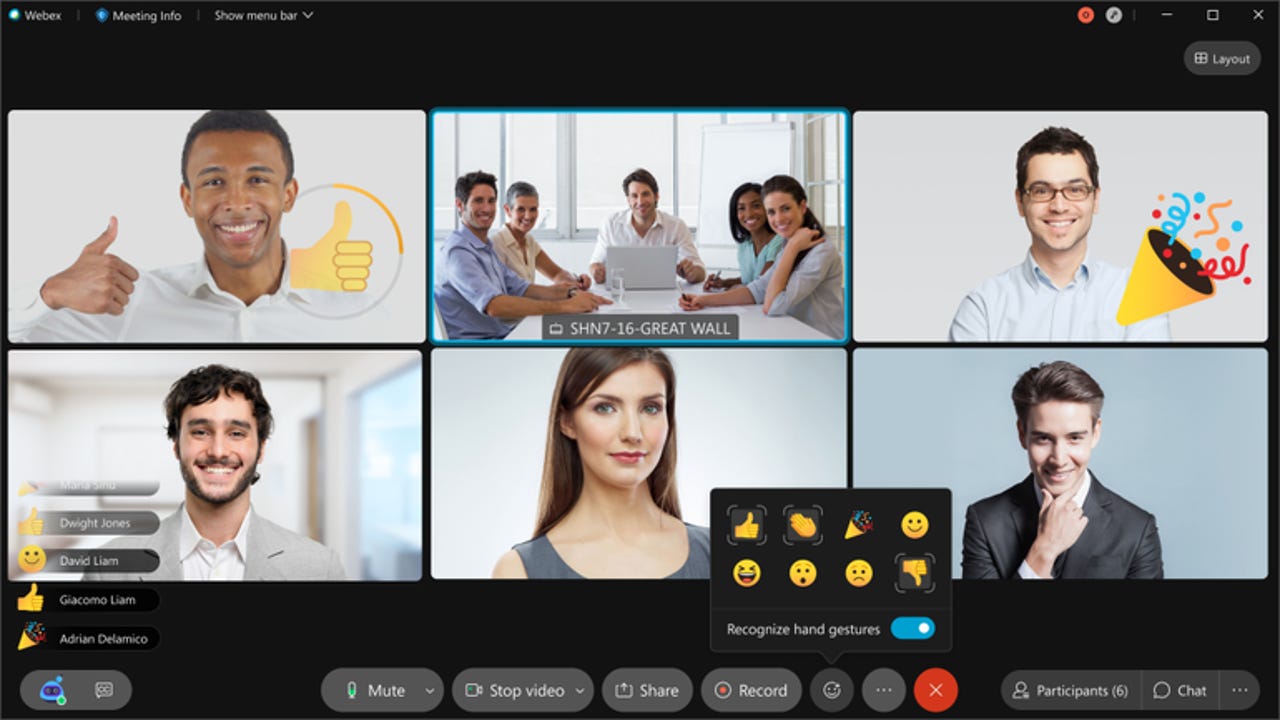Cisco unveils revamped Webex experience, including noise cancellation, AI-powered gesture recognition


Cisco announced a bevy of new features within its Webex portfolio on Tuesday, as the company ramps up its efforts to compete with rival collaboration players such as Zoom, Slack, Google Meet and Microsoft Teams.
Featured
The updates, released as part of Cisco's WebexOne virtual event, come as Webex and other video conferencing and cloud collaboration tools experience huge spikes in usage due to the number of workers staying productive remotely through the COVID-19 pandemic.
The new feature updates -- which are designed to position Webex as a key platform for the future of work -- include new capabilities for its meetings, calling, messaging, and contact center services, as well as new devices. All told, Cisco debuted more than 50 product updates aimed at providing seamless collaboration and smart hybrid work experiences.
At the center of the updates is what Cisco says is an all new Webex experience. Available today, the new Webex combines calling, meetings and messaging into one app via Webex Teams.
New capabilities on the meetings side include automatic noise cancellation, searchable transcriptions and closed captioning, and improved video layouts that let users highlight individual speakers on their own screen. There's also a new huddle tool that lets users call specific team members into a impromptu meeting with a single click, without the need to schedule or send calendar invites.
In messaging, Cisco is adding new AI to Webex that will enable the app to learn what projects, spaces and people are most important to each user, and then elevate them so they're easier to locate. The app will also include new Webex message pinning and the ability to automatically send recorded meetings to specified groups and individuals.
Within Webex calling, Cisco is adding new call routing features such as video on hold and interactive voice response. Cisco says it has also made it easier to escalate voice calls to video meetings, and added new calling plans for customers.
The company is also bolstering the analytics capabilities within Webex with a new suite of features powered by the Webex Graph, such as personalized insights and actionable recommendations to individuals, teams and organizations.
On the contact center side, Cisco said it has expanded the platform to support businesses of all sizes, meaning the system will be able to field customer service requests to thousands of virtual agents. Meanwhile, Cisco is implementing a new microservices architecture to enable more customization, and incorporating text and social channels into the contact center fray. Cisco is also adding new AI-powered voice and chat bots and integrating Webex Experience Management with Webex Contact Center.
Cisco also teased some new features that are set to debut in fiscal 2021, such as AI-powered in-meeting gestures, which will enable users to communicate with others on a call by giving a thumbs-up, for instance. The AI in Webex will recognize physical gestures and translate the motion into an emoji on the screen that other participants can see. Cisco says this feature is an industry first.
"Gesture recognition is going to be game changing in so many ways because people won't have to learn how to do something new," said Jeetu Patel, the SVP and GM of Cisco's security and applications business. "They can just do what they normally do and have it show up as a reaction."
Webex will also gain real-time translation capabilities in February, the company said. Transcription will be available in 10 languages, including English, Spanish, French, German, Mandarin, Portuguese, Arabic, Russian, Dutch, and Japanese.
"A lot of these capabilities and features, none of our competitors have," Patel said.
Cisco is also doubling down on its partner ecosystem, announcing a new App Hub that will make integrations with third-party services more seamless. With App Hub, meeting participants can find and use integrations with services such as Box, Dropbox, Salesforce, ServiceNow and Workplace from Facebook, among others.
"Our vision with building a strong open ecosystem-based approach for partners is to make sure that regardless of the application someone is using, they can work seamlessly with Webex," Patel said.
In terms of devices, Cisco unveiled the new Webex Desk Camera, Webex Desk Hub and Webex Desk. The new hardware is meant to help organizations rethink office spaces and the ways people work, the company said.
"Customers are telling us that they are rethinking their office spaces -- many are moving towards hybrid work with more people working at home and more hotdesks in the office," said Patel. "So we are excited to be introducing two new devices, Webex Desk Camera and Webex Desk, that can be used at home or in the office as well as a brand new device called the Webex Desk Hub -- a first for the industry -- that allows personalized working in a shared space."